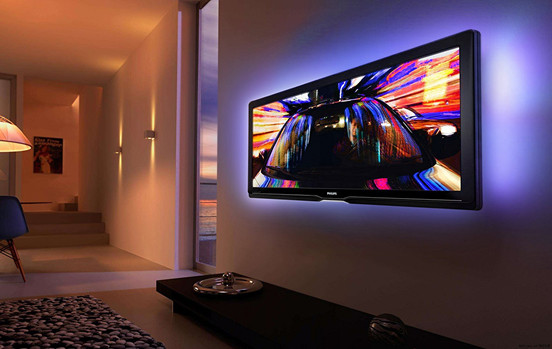
A Guide To Bias Lights – The Saviors For Your Eyes
By Hagan Schmidt, COO & Lighting Expert – 09/19/17
Has watching television or spending hours on your computer left you with discomfort and headaches? Many people spend countless hours in front of a screen, be it a television or monitor. Our eyes dilate each time we look at a screen as they are exposed to the light present in front of us. If the light isn’t present in the overall scenery and comes from one specific location, it puts more strain on the eyes.
Most of us, when we watch television, prefer to have the lights dim or turned off. This makes the screen the only source of light, leaving the rest of our vision scenery completely black. This puts strain on the eyes. It is important to have light around the screen so the eyes can sort of ease itself when viewing the screen. This is where bias lights come in to play.
What is bias lighting?
We know, no one likes to watch television with the lights completely on. It ruins the overall viewing pleasure and leads to glare on the screen. Bias lights on the other hand not only optimize your viewing pleasure, but also help relieve the strain on your eyes from excess viewing. What bias lights do is they introduce general luminance around the television, in the room, without any mainstream distribution.
Bias lights are strategically placed behind your screen, so they introduce light in your viewing background scenery. Since the light is directly behind the screen, it doesn’t glare on to the screen or shine directly at you from any angle. This can easily be done in your living room or office space.
Setting up bias lights
The first thing you need to consider when you decide to install bias lighting is select the correct color temperature. For home theater setups, you want a nice cool white color. You want to select a color that is similar to that which your television emits. Typical HDTV screens are calibrated to and emit around 6000K so you want bias lighting that ranges from 5,000-6,000K. While typical light bulbs have a color temperature of around 2700K, they are generally not a good option for bias lighting. You will need to get specific bulbs for this task.
LED strip lights work well in cool white. You can easily set them up behind your television or screen and they emit the perfect amount of light to allow your eyes to ease their vision into the screen rather than strain them.
Other benefits of bias lighting
Bias lights not only reduce the strain on your eyes but improve your viewing pleasure. It greatly improves the contrast of your screen. The below contrast test can help explain that better:

The bar in the middle is a uniform grey color throughout. However, against a dark background it is perceived by our eyes to be lighter. Adding bias lights, enables you to get the perfect contrast from your screen and every color appears to the eyes as they should.
Adding LED bias lights, will also allow you to keep the brightness on your television low. This helps extend the life of your television screen. Bias lighting can also be a part of the overall lighting setup for your home theater to ensure you have optimal viewing experience.
Bias lights help set up the ideal viewing experience that will optimize your overall home theater experience. It isn’t hard to set up and you can even purchase commercially assembled bias lights if you don’t want to make your own. So what are you waiting for? Don’t you want to enhance your viewing pleasure? Get bias lights and say good-bye to eyestrain and headaches and hello to the best viewing experience of your life.
About the author
Katie Porter is an aspiring writer, movie lover, and part of the team at Seatup. In her free time, she enjoys exploring her home state Colorado and plays in women’s amateur rugby league.


